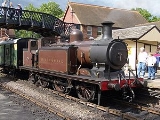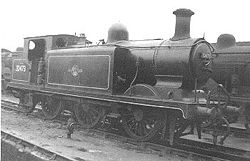
LB&SCR E4 Class
Encyclopedia
The London, Brighton and South Coast Railway
E4 Class is a class of 0-6-2Tside tank steam locomotive
designed by Robert Billinton
. They were introduced in 1897 and were essentially a larger version of the E3 Class
. Cylinder diameter was reduced from 18 to 17.5 in (457.2 to 444.5 mm) by the Southern Railway
.
tanks" were powerful for their size and were stalwarts of local passenger, freight and branch work for more than fifty years. Seventy-five members of the class were built by Brighton Works
between December 1897 and September 1903. All of the class survived the transfer to Southern Railway
ownership in 1923. One example was however destroyed as a result of enemy action against Eastbourne
motive power depot in 1942. The remainder continued in regular use following the nationalisation of the Southern Railway to become a part of British Railways in 1948. However, with the arrival of Diesel Multiple Units and the reduction in the number of branch lines following the Beeching Axe
, the locomotives gradually became surplus to operational requirements, and withdrawals commenced in 1955. Most of the class were withdrawn between 1958 and 1964.
 The E4 class were initially used on local passenger and freight services, and on branch lines.
The E4 class were initially used on local passenger and freight services, and on branch lines.
Later in British Railways days, several examples were found new jobs as station pilots, most famously at London Waterloo, where they brought empty carriage rakes into the station from the yards at Clapham Junction. They were also used on services such as the locally famous Lancing Belle, which ran from Brighton
to the Lancing Carriage Works
of the London, Brighton and South Coast Railway
, often double-headed with members of the same class or the larger E6 class.
with larger boilers and designated E4X. These became BR numbers 32466, 32477, 32478 and 32489.
in East Sussex
, where it has remained ever since, except for visits to other lines such as the Severn Valley Railway
and Isle of Wight Steam Railway
. The engine was withdrawn from traffic in 1971 and dismantled. Work however did not start in earnest until the 1980s and following a long overhaul, she returned to traffic in 1997 to celebrate her centenary in 1998. She was painted in the completely non-standard LBSC Marsh Umber livery with the name Birch Grove on the side tanks. In 2005 she was repainted into British Railways lined black passenger livery. Following withdrawal from service in May 2008, the locomotive was soon brought into the Bluebell workshops for a fast track overhaul, including a repaint into 1920s Southern Railway green to match much of the line's coaching stock. This was completed during January 2010, with the engine relaunched into traffic on 30 January 2010.
London, Brighton and South Coast Railway
The London, Brighton and South Coast Railway was a railway company in the United Kingdom from 1846 to 1922. Its territory formed a rough triangle, with London at its apex, practically the whole coastline of Sussex as its base, and a large part of Surrey...
E4 Class is a class of 0-6-2Tside tank steam locomotive
Steam locomotive
A steam locomotive is a railway locomotive that produces its power through a steam engine. These locomotives are fueled by burning some combustible material, usually coal, wood or oil, to produce steam in a boiler, which drives the steam engine...
designed by Robert Billinton
R. J. Billinton
Robert John Billinton was the Locomotive, Carriage, Wagon and Marine Superintendent of the London, Brighton and South Coast Railway from 1890 until his death.-Early career:...
. They were introduced in 1897 and were essentially a larger version of the E3 Class
LB&SCR E3 Class
The London, Brighton and South Coast Railway E3 Class were 0-6-2Tside tank steam locomotives. Seventeen were built and they were designed by R. J. Billinton as a development of an earlier design by William Stroudley....
. Cylinder diameter was reduced from 18 to 17.5 in (457.2 to 444.5 mm) by the Southern Railway
Southern Railway (Great Britain)
The Southern Railway was a British railway company established in the 1923 Grouping. It linked London with the Channel ports, South West England, South coast resorts and Kent...
.
History
The E4 class of "radialRadial axle
A radial axle is an axle on a railway locomotive or carriage which has been designed to move laterally when entering a curve in order to reduce the flange and rail wear....
tanks" were powerful for their size and were stalwarts of local passenger, freight and branch work for more than fifty years. Seventy-five members of the class were built by Brighton Works
Brighton railway works
Brighton railway works was one of the earliest railway-owned locomotive repair works, founded in 1840 by the London and Brighton Railway in Brighton, England, and thus pre-dating the more famous railway works at Crewe, Doncaster and Swindon...
between December 1897 and September 1903. All of the class survived the transfer to Southern Railway
Southern Railway (Great Britain)
The Southern Railway was a British railway company established in the 1923 Grouping. It linked London with the Channel ports, South West England, South coast resorts and Kent...
ownership in 1923. One example was however destroyed as a result of enemy action against Eastbourne
Eastbourne
Eastbourne is a large town and borough in East Sussex, on the south coast of England between Brighton and Hastings. The town is situated at the eastern end of the chalk South Downs alongside the high cliff at Beachy Head...
motive power depot in 1942. The remainder continued in regular use following the nationalisation of the Southern Railway to become a part of British Railways in 1948. However, with the arrival of Diesel Multiple Units and the reduction in the number of branch lines following the Beeching Axe
Beeching Axe
The Beeching Axe or the Beeching Cuts are informal names for the British Government's attempt in the 1960s to reduce the cost of running British Railways, the nationalised railway system in the United Kingdom. The name is that of the main author of The Reshaping of British Railways, Dr Richard...
, the locomotives gradually became surplus to operational requirements, and withdrawals commenced in 1955. Most of the class were withdrawn between 1958 and 1964.
Operations

Later in British Railways days, several examples were found new jobs as station pilots, most famously at London Waterloo, where they brought empty carriage rakes into the station from the yards at Clapham Junction. They were also used on services such as the locally famous Lancing Belle, which ran from Brighton
Brighton
Brighton is the major part of the city of Brighton and Hove in East Sussex, England on the south coast of Great Britain...
to the Lancing Carriage Works
Lancing Carriage Works
Lancing carriage and wagon works was a railway carriage and wagon building and maintenance facility in the village of Lancing in the county of West Sussex in England from 1911 until 1965.-History under the LB&SCR:...
of the London, Brighton and South Coast Railway
London, Brighton and South Coast Railway
The London, Brighton and South Coast Railway was a railway company in the United Kingdom from 1846 to 1922. Its territory formed a rough triangle, with London at its apex, practically the whole coastline of Sussex as its base, and a large part of Surrey...
, often double-headed with members of the same class or the larger E6 class.
E4X class
In 1909, four locomotives were rebuilt by D. E. MarshD. E. Marsh
Douglas Earle Marsh was the Locomotive, Carriage and Wagon Superintendent of the London, Brighton and South Coast Railway from November 1904 until his early retirement on health grounds in July 1911.-Early career:...
with larger boilers and designated E4X. These became BR numbers 32466, 32477, 32478 and 32489.
Preservation
One of the last survivors in 1963 was no.32473. This was purchased by a group of preservationists and brought to the Bluebell RailwayBluebell Railway
The Bluebell Railway is a heritage line running for nine miles along the border between East and West Sussex, England. Steam trains are operated between and , with an intermediate station at .The railway is managed and run largely by volunteers...
in East Sussex
East Sussex
East Sussex is a county in South East England. It is bordered by the counties of Kent, Surrey and West Sussex, and to the south by the English Channel.-History:...
, where it has remained ever since, except for visits to other lines such as the Severn Valley Railway
Severn Valley Railway
The Severn Valley Railway is a heritage railway in Shropshire and Worcestershire, England. The line runs along the Severn Valley from Bridgnorth to Kidderminster, following the course of the River Severn for much of its route...
and Isle of Wight Steam Railway
Isle of Wight Steam Railway
The Isle of Wight Steam Railway is a heritage railway on the Isle of Wight. The railway passes through 5½ miles of unspoiled countryside from to station, passing through the small village of Havenstreet, where the line has a station, headquarters and a depot...
. The engine was withdrawn from traffic in 1971 and dismantled. Work however did not start in earnest until the 1980s and following a long overhaul, she returned to traffic in 1997 to celebrate her centenary in 1998. She was painted in the completely non-standard LBSC Marsh Umber livery with the name Birch Grove on the side tanks. In 2005 she was repainted into British Railways lined black passenger livery. Following withdrawal from service in May 2008, the locomotive was soon brought into the Bluebell workshops for a fast track overhaul, including a repaint into 1920s Southern Railway green to match much of the line's coaching stock. This was completed during January 2010, with the engine relaunched into traffic on 30 January 2010.
Sources
- Ian Allan ABC of British Railways Locomotives, 1949, part 2, page 35
- Bradley, D.L. (1974) Locomotives of the London Brighton and South Coast Railway, Part 3. Railway Correspondence and Travel Society.

